Exploring Identity and Social Differences in Early Childhood Education
VerifiedAdded on 2020/03/04
|5
|1183
|56
Essay
AI Summary
This essay delves into the intricate relationship between identity and social differences within the context of early childhood education and care in Australia. It begins by defining identity through an Eriksonian lens, highlighting how cultural diversity, particularly the presence of both indigenous and non-indigenous populations, shapes individual and group identities. The essay then examines the impact of race, ethnicity, and social factors like education, religion, and health on the formation of these identities. It further explores how social differences, stemming from diverse origins, influence social groups and impact the education system, particularly for Aboriginal children. The essay concludes by emphasizing the need to understand and address these differences to achieve national goals and objectives in education and beyond. The essay references several academic sources to support its arguments.
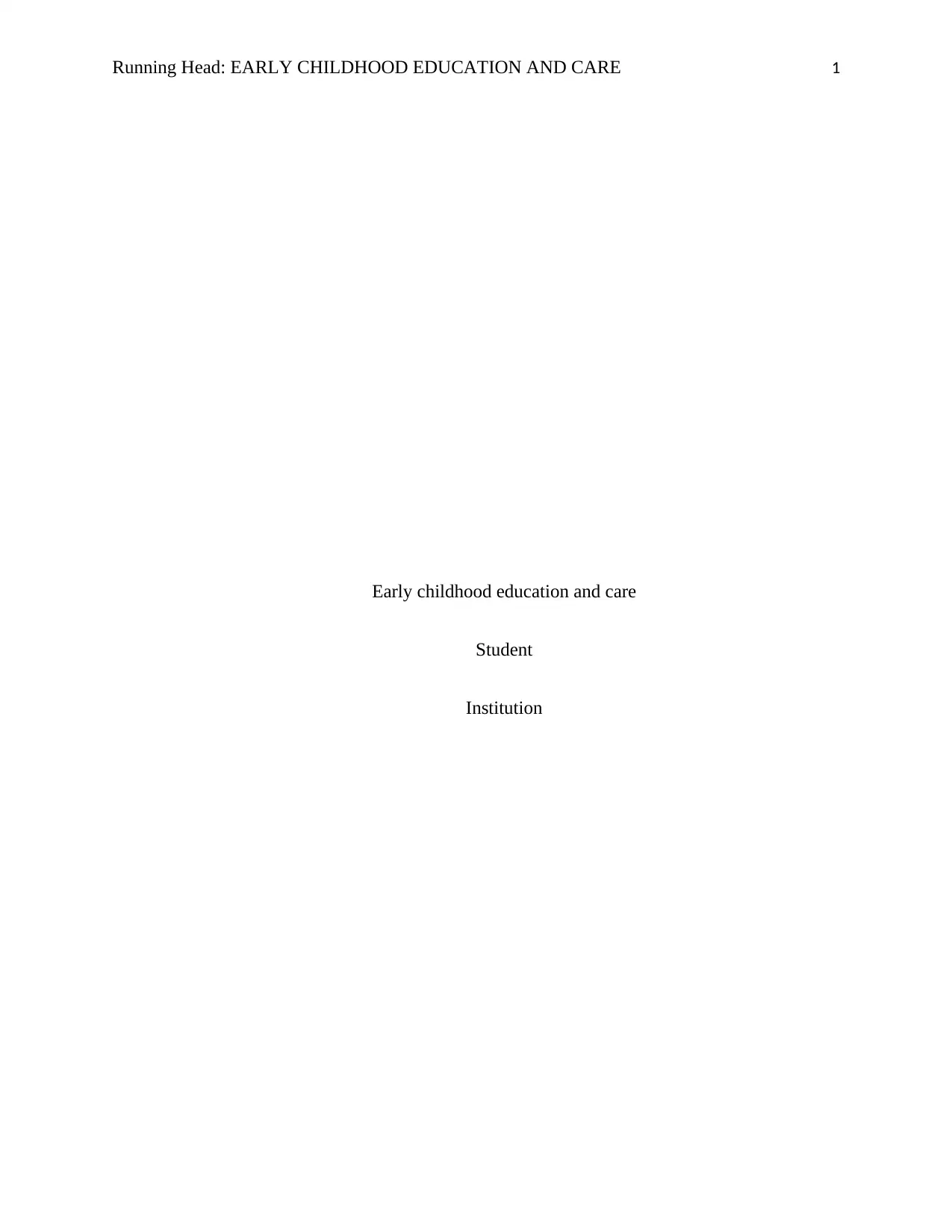
Running Head: EARLY CHILDHOOD EDUCATION AND CARE 1
Early childhood education and care
Student
Institution
Early childhood education and care
Student
Institution
Paraphrase This Document
Need a fresh take? Get an instant paraphrase of this document with our AI Paraphraser
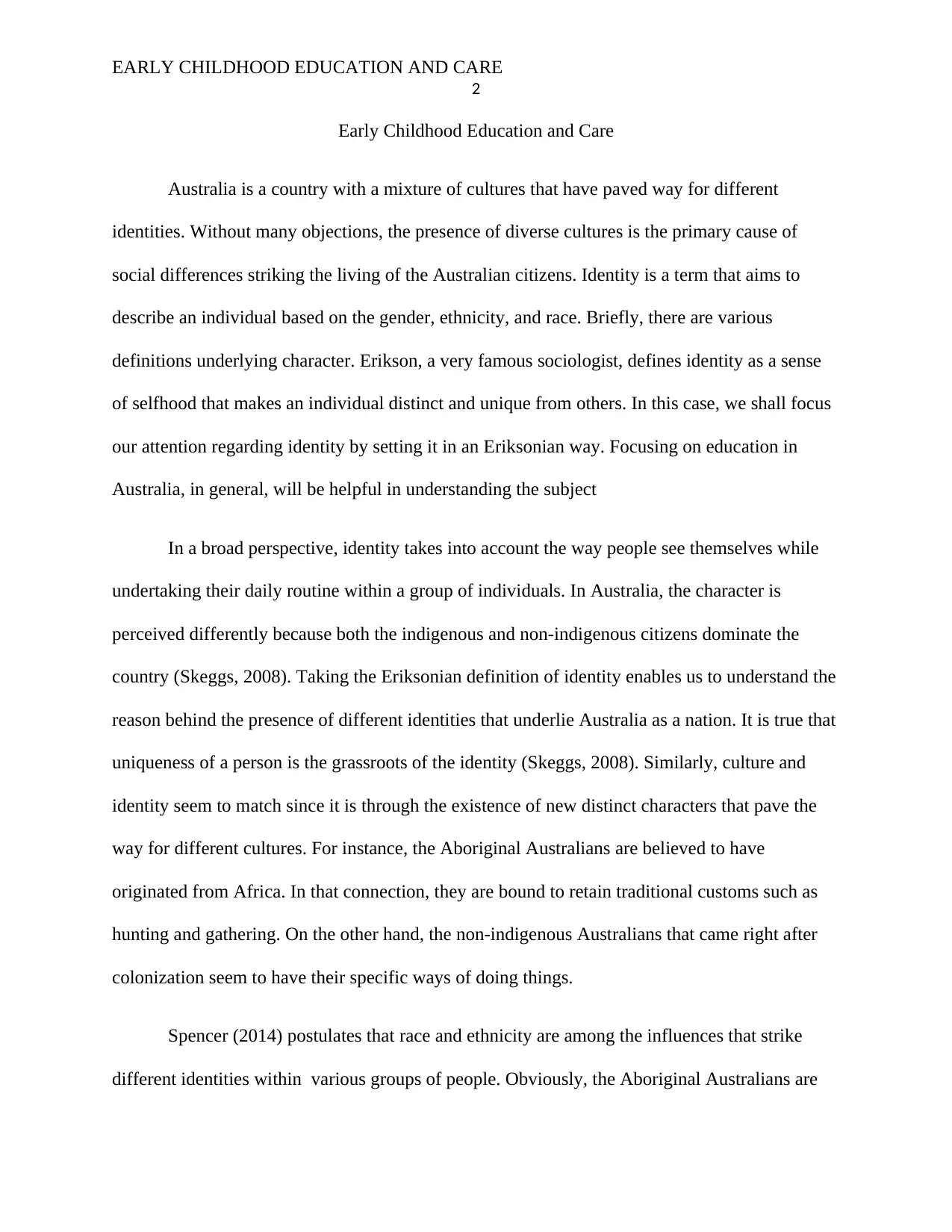
EARLY CHILDHOOD EDUCATION AND CARE
2
Early Childhood Education and Care
Australia is a country with a mixture of cultures that have paved way for different
identities. Without many objections, the presence of diverse cultures is the primary cause of
social differences striking the living of the Australian citizens. Identity is a term that aims to
describe an individual based on the gender, ethnicity, and race. Briefly, there are various
definitions underlying character. Erikson, a very famous sociologist, defines identity as a sense
of selfhood that makes an individual distinct and unique from others. In this case, we shall focus
our attention regarding identity by setting it in an Eriksonian way. Focusing on education in
Australia, in general, will be helpful in understanding the subject
In a broad perspective, identity takes into account the way people see themselves while
undertaking their daily routine within a group of individuals. In Australia, the character is
perceived differently because both the indigenous and non-indigenous citizens dominate the
country (Skeggs, 2008). Taking the Eriksonian definition of identity enables us to understand the
reason behind the presence of different identities that underlie Australia as a nation. It is true that
uniqueness of a person is the grassroots of the identity (Skeggs, 2008). Similarly, culture and
identity seem to match since it is through the existence of new distinct characters that pave the
way for different cultures. For instance, the Aboriginal Australians are believed to have
originated from Africa. In that connection, they are bound to retain traditional customs such as
hunting and gathering. On the other hand, the non-indigenous Australians that came right after
colonization seem to have their specific ways of doing things.
Spencer (2014) postulates that race and ethnicity are among the influences that strike
different identities within various groups of people. Obviously, the Aboriginal Australians are
2
Early Childhood Education and Care
Australia is a country with a mixture of cultures that have paved way for different
identities. Without many objections, the presence of diverse cultures is the primary cause of
social differences striking the living of the Australian citizens. Identity is a term that aims to
describe an individual based on the gender, ethnicity, and race. Briefly, there are various
definitions underlying character. Erikson, a very famous sociologist, defines identity as a sense
of selfhood that makes an individual distinct and unique from others. In this case, we shall focus
our attention regarding identity by setting it in an Eriksonian way. Focusing on education in
Australia, in general, will be helpful in understanding the subject
In a broad perspective, identity takes into account the way people see themselves while
undertaking their daily routine within a group of individuals. In Australia, the character is
perceived differently because both the indigenous and non-indigenous citizens dominate the
country (Skeggs, 2008). Taking the Eriksonian definition of identity enables us to understand the
reason behind the presence of different identities that underlie Australia as a nation. It is true that
uniqueness of a person is the grassroots of the identity (Skeggs, 2008). Similarly, culture and
identity seem to match since it is through the existence of new distinct characters that pave the
way for different cultures. For instance, the Aboriginal Australians are believed to have
originated from Africa. In that connection, they are bound to retain traditional customs such as
hunting and gathering. On the other hand, the non-indigenous Australians that came right after
colonization seem to have their specific ways of doing things.
Spencer (2014) postulates that race and ethnicity are among the influences that strike
different identities within various groups of people. Obviously, the Aboriginal Australians are
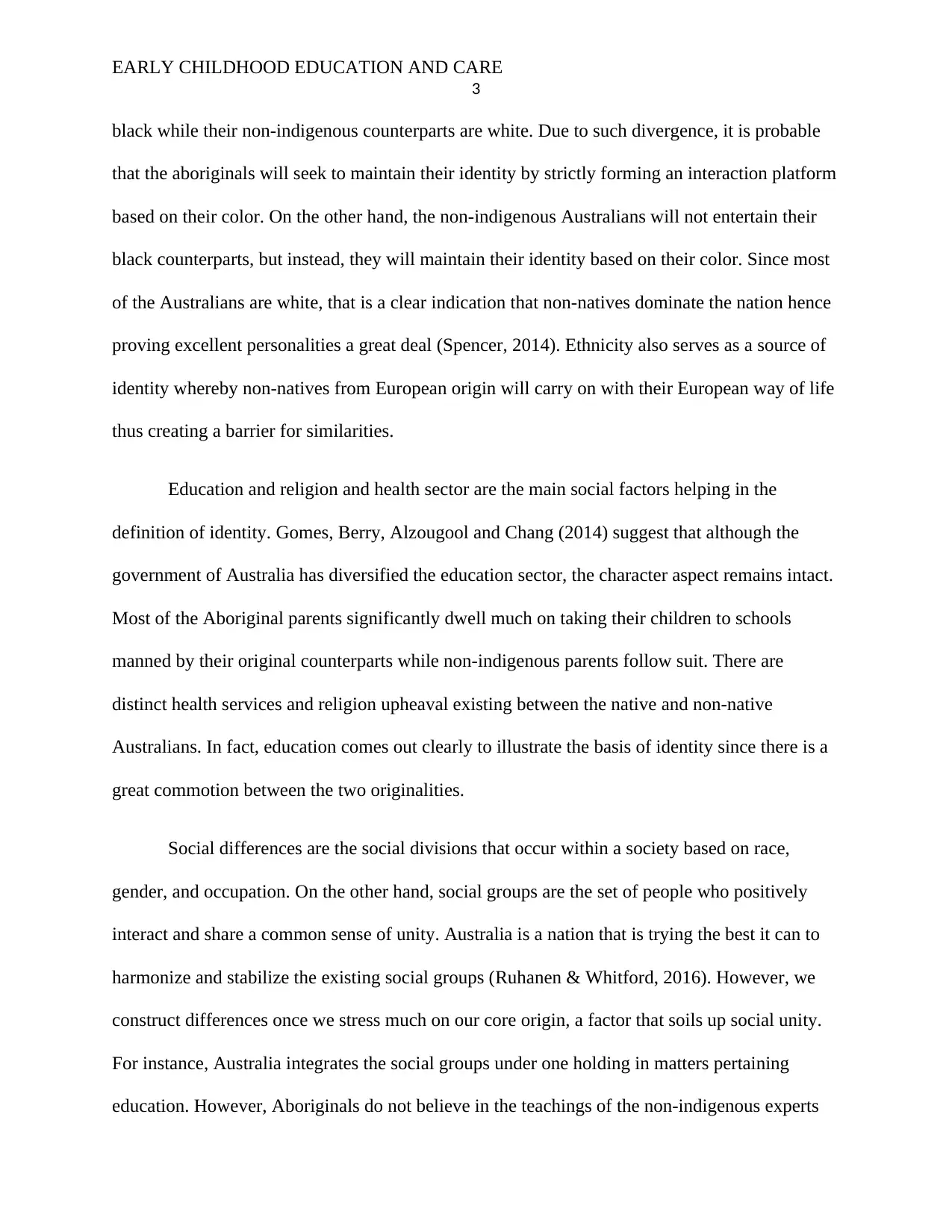
EARLY CHILDHOOD EDUCATION AND CARE
3
black while their non-indigenous counterparts are white. Due to such divergence, it is probable
that the aboriginals will seek to maintain their identity by strictly forming an interaction platform
based on their color. On the other hand, the non-indigenous Australians will not entertain their
black counterparts, but instead, they will maintain their identity based on their color. Since most
of the Australians are white, that is a clear indication that non-natives dominate the nation hence
proving excellent personalities a great deal (Spencer, 2014). Ethnicity also serves as a source of
identity whereby non-natives from European origin will carry on with their European way of life
thus creating a barrier for similarities.
Education and religion and health sector are the main social factors helping in the
definition of identity. Gomes, Berry, Alzougool and Chang (2014) suggest that although the
government of Australia has diversified the education sector, the character aspect remains intact.
Most of the Aboriginal parents significantly dwell much on taking their children to schools
manned by their original counterparts while non-indigenous parents follow suit. There are
distinct health services and religion upheaval existing between the native and non-native
Australians. In fact, education comes out clearly to illustrate the basis of identity since there is a
great commotion between the two originalities.
Social differences are the social divisions that occur within a society based on race,
gender, and occupation. On the other hand, social groups are the set of people who positively
interact and share a common sense of unity. Australia is a nation that is trying the best it can to
harmonize and stabilize the existing social groups (Ruhanen & Whitford, 2016). However, we
construct differences once we stress much on our core origin, a factor that soils up social unity.
For instance, Australia integrates the social groups under one holding in matters pertaining
education. However, Aboriginals do not believe in the teachings of the non-indigenous experts
3
black while their non-indigenous counterparts are white. Due to such divergence, it is probable
that the aboriginals will seek to maintain their identity by strictly forming an interaction platform
based on their color. On the other hand, the non-indigenous Australians will not entertain their
black counterparts, but instead, they will maintain their identity based on their color. Since most
of the Australians are white, that is a clear indication that non-natives dominate the nation hence
proving excellent personalities a great deal (Spencer, 2014). Ethnicity also serves as a source of
identity whereby non-natives from European origin will carry on with their European way of life
thus creating a barrier for similarities.
Education and religion and health sector are the main social factors helping in the
definition of identity. Gomes, Berry, Alzougool and Chang (2014) suggest that although the
government of Australia has diversified the education sector, the character aspect remains intact.
Most of the Aboriginal parents significantly dwell much on taking their children to schools
manned by their original counterparts while non-indigenous parents follow suit. There are
distinct health services and religion upheaval existing between the native and non-native
Australians. In fact, education comes out clearly to illustrate the basis of identity since there is a
great commotion between the two originalities.
Social differences are the social divisions that occur within a society based on race,
gender, and occupation. On the other hand, social groups are the set of people who positively
interact and share a common sense of unity. Australia is a nation that is trying the best it can to
harmonize and stabilize the existing social groups (Ruhanen & Whitford, 2016). However, we
construct differences once we stress much on our core origin, a factor that soils up social unity.
For instance, Australia integrates the social groups under one holding in matters pertaining
education. However, Aboriginals do not believe in the teachings of the non-indigenous experts
⊘ This is a preview!⊘
Do you want full access?
Subscribe today to unlock all pages.

Trusted by 1+ million students worldwide
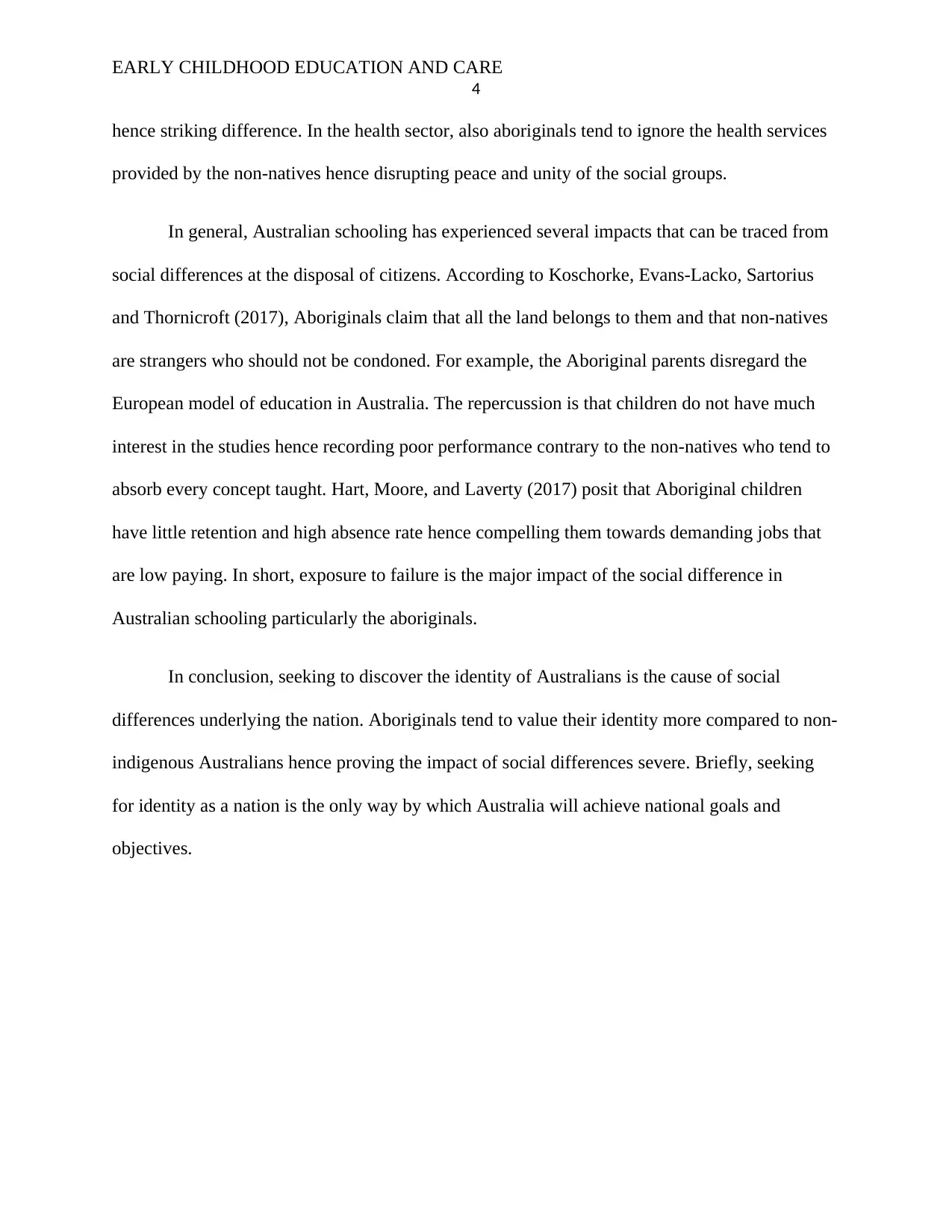
EARLY CHILDHOOD EDUCATION AND CARE
4
hence striking difference. In the health sector, also aboriginals tend to ignore the health services
provided by the non-natives hence disrupting peace and unity of the social groups.
In general, Australian schooling has experienced several impacts that can be traced from
social differences at the disposal of citizens. According to Koschorke, Evans-Lacko, Sartorius
and Thornicroft (2017), Aboriginals claim that all the land belongs to them and that non-natives
are strangers who should not be condoned. For example, the Aboriginal parents disregard the
European model of education in Australia. The repercussion is that children do not have much
interest in the studies hence recording poor performance contrary to the non-natives who tend to
absorb every concept taught. Hart, Moore, and Laverty (2017) posit that Aboriginal children
have little retention and high absence rate hence compelling them towards demanding jobs that
are low paying. In short, exposure to failure is the major impact of the social difference in
Australian schooling particularly the aboriginals.
In conclusion, seeking to discover the identity of Australians is the cause of social
differences underlying the nation. Aboriginals tend to value their identity more compared to non-
indigenous Australians hence proving the impact of social differences severe. Briefly, seeking
for identity as a nation is the only way by which Australia will achieve national goals and
objectives.
4
hence striking difference. In the health sector, also aboriginals tend to ignore the health services
provided by the non-natives hence disrupting peace and unity of the social groups.
In general, Australian schooling has experienced several impacts that can be traced from
social differences at the disposal of citizens. According to Koschorke, Evans-Lacko, Sartorius
and Thornicroft (2017), Aboriginals claim that all the land belongs to them and that non-natives
are strangers who should not be condoned. For example, the Aboriginal parents disregard the
European model of education in Australia. The repercussion is that children do not have much
interest in the studies hence recording poor performance contrary to the non-natives who tend to
absorb every concept taught. Hart, Moore, and Laverty (2017) posit that Aboriginal children
have little retention and high absence rate hence compelling them towards demanding jobs that
are low paying. In short, exposure to failure is the major impact of the social difference in
Australian schooling particularly the aboriginals.
In conclusion, seeking to discover the identity of Australians is the cause of social
differences underlying the nation. Aboriginals tend to value their identity more compared to non-
indigenous Australians hence proving the impact of social differences severe. Briefly, seeking
for identity as a nation is the only way by which Australia will achieve national goals and
objectives.
Paraphrase This Document
Need a fresh take? Get an instant paraphrase of this document with our AI Paraphraser
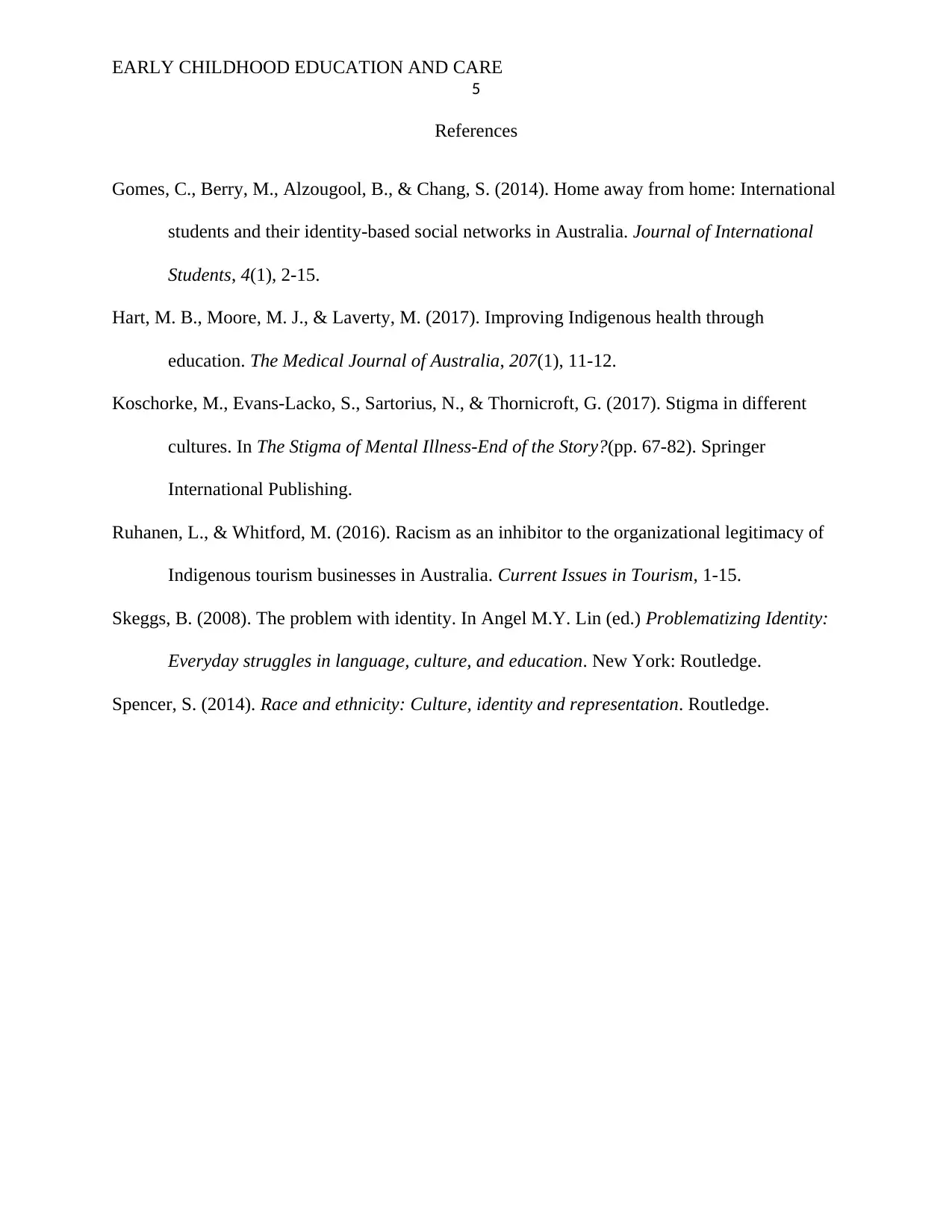
EARLY CHILDHOOD EDUCATION AND CARE
5
References
Gomes, C., Berry, M., Alzougool, B., & Chang, S. (2014). Home away from home: International
students and their identity-based social networks in Australia. Journal of International
Students, 4(1), 2-15.
Hart, M. B., Moore, M. J., & Laverty, M. (2017). Improving Indigenous health through
education. The Medical Journal of Australia, 207(1), 11-12.
Koschorke, M., Evans-Lacko, S., Sartorius, N., & Thornicroft, G. (2017). Stigma in different
cultures. In The Stigma of Mental Illness-End of the Story?(pp. 67-82). Springer
International Publishing.
Ruhanen, L., & Whitford, M. (2016). Racism as an inhibitor to the organizational legitimacy of
Indigenous tourism businesses in Australia. Current Issues in Tourism, 1-15.
Skeggs, B. (2008). The problem with identity. In Angel M.Y. Lin (ed.) Problematizing Identity:
Everyday struggles in language, culture, and education. New York: Routledge.
Spencer, S. (2014). Race and ethnicity: Culture, identity and representation. Routledge.
5
References
Gomes, C., Berry, M., Alzougool, B., & Chang, S. (2014). Home away from home: International
students and their identity-based social networks in Australia. Journal of International
Students, 4(1), 2-15.
Hart, M. B., Moore, M. J., & Laverty, M. (2017). Improving Indigenous health through
education. The Medical Journal of Australia, 207(1), 11-12.
Koschorke, M., Evans-Lacko, S., Sartorius, N., & Thornicroft, G. (2017). Stigma in different
cultures. In The Stigma of Mental Illness-End of the Story?(pp. 67-82). Springer
International Publishing.
Ruhanen, L., & Whitford, M. (2016). Racism as an inhibitor to the organizational legitimacy of
Indigenous tourism businesses in Australia. Current Issues in Tourism, 1-15.
Skeggs, B. (2008). The problem with identity. In Angel M.Y. Lin (ed.) Problematizing Identity:
Everyday struggles in language, culture, and education. New York: Routledge.
Spencer, S. (2014). Race and ethnicity: Culture, identity and representation. Routledge.
1 out of 5
Related Documents
Your All-in-One AI-Powered Toolkit for Academic Success.
+13062052269
info@desklib.com
Available 24*7 on WhatsApp / Email
![[object Object]](/_next/static/media/star-bottom.7253800d.svg)
Unlock your academic potential
Copyright © 2020–2025 A2Z Services. All Rights Reserved. Developed and managed by ZUCOL.





